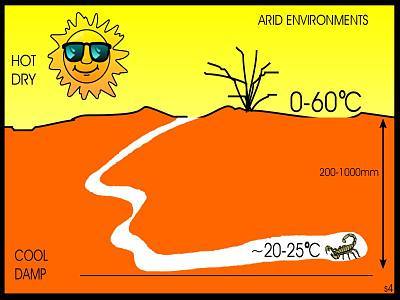
-Scorpion Enthusiasts Home Page-

 Burrowing ability allows U.yaschenkoi to successfully inhabit an arid environment.
Burrowing ability allows U.yaschenkoi to successfully inhabit an arid environment.
Survival in a desert environment is difficult for any organism, Urodacus yaschenkoi's successful adaptation to arid conditions has allowed it to attain large population numbers and be one of the most common organisms to inhabit Australia's interior.
U. yaschenkoi is found from South Eastern Central Australia, in the Renmark/Berri area diagonally across the interior to the North West coast. The studies I have done on yaschenkoi were made North of Berri in South Australia and only relate to those animals. Urodacus yaschenkoi almost exclusively inhabits sandy soil country , there are areas where hard soil meets sandy soil and you can stand in the middle and see that yaschenkoi is virtually non-existant in the hard soil area and plentiful within the sandy soil area. It's that clear cut, the vegetation changes from Eucalypts and small shrubs in the sandy soil conditions to predominately Casuarina pines and bluebush in the hard soil areas. Pockets of hard ground occur within the sandy area and vice versa, either way yaschenkoi only exploits the sandy soil type, with very few individuals occuring in the harder soil type....seems like a niche just waiting. It would appear as though fitness of the animal is markedly reduced within the harder soil type.
Lets take a closer look at the burrow.
The entrance to the burrow is called the entrance chamber with an angle of entry around 15-45 degrees below the horizontal ground level. The length varies, being longer in younger instars and shortest in adults. Width of the entrance at the mouth ranged from 20-35mm. The final section of the burrow is the terminal chamber where the scorpion spends most of its time, this area is a "living" area and hence is large enough to move around easily in. It's highly variable in length and sometimes has an additional side chamber. The 5 different instars that dig burrows, instars 2-6, all dig to a deeper depth than the previous instar, and all dig burrows with the same three components, entrance chamber, spiral section and the terminal chamber. Have a look at this generalised diagram showing the variance of burrow structure between instars.
|